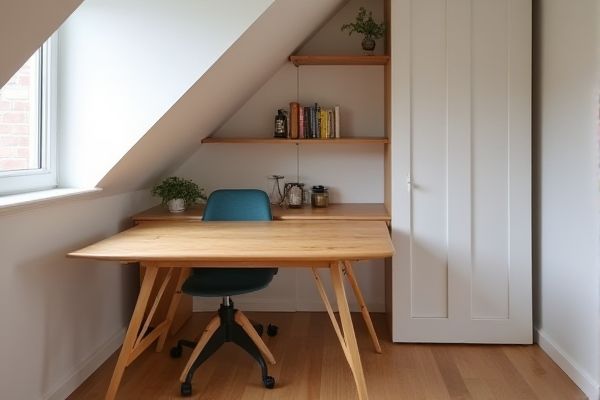
Attic Murphy tables save space by folding vertically against the wall, providing a sleek, concealed surface, while fold-down tables typically attach to a wall or cabinet and fold horizontally, offering versatile workspace options. Explore the full comparison to discover which design best suits Your space-saving needs and lifestyle.
Table of Comparison
| Feature | Attic Murphy Table | Fold-Down Table |
|---|---|---|
| Design | Integrated Murphy table stored vertically in attic space | Wall-mounted or cabinet-attached, folds horizontally |
| Space Saving | Maximizes attic storage by doubling as a hidden table | Optimizes wall space, ideal for small rooms |
| Installation | Requires attic-specific mounting and space clearance | Simple wall or cabinet installation |
| Usage | Suitable for occasional use, working or dining in attic | Frequent folding and unfolding, convenient for daily use |
| Weight Capacity | Generally sturdy, supports moderate loads | Varies by model, often lighter use capacity |
| Maintenance | Less frequent use, minimal maintenance | Requires regular inspection due to frequent movement |
| Cost | Higher due to custom attic fitting | Affordable and widely available |
Attic Murphy Table vs Fold-Down Table: Key Differences
Attic Murphy tables are designed for space-saving in loft or attic rooms, offering a sturdy, vertical fold mechanism that maximizes floor space by folding up against a sloped ceiling. Fold-down tables, often mounted on walls, provide versatile horizontal surfaces that easily collapse downward for quick access but may require more wall clearance. Attic Murphy tables excel in optimizing awkward attic angles, while fold-down tables offer flexible placement in living rooms, kitchens, or offices.
Space-Saving Solutions for Small Homes
The attic Murphy table and fold-down table both maximize space efficiency in small homes by offering versatile, wall-mounted designs that tuck away when not in use. Murphy tables typically provide a larger surface area ideal for dining or work, while fold-down tables excel in compact zones, folding flat to free up floor space instantly. Choosing between these space-saving solutions depends on room size, required table functionality, and desired ease of storage.
Design and Style Comparison
The Attic Murphy table features a sleek, space-saving design with a folding mechanism that blends seamlessly into wall decor, ideal for minimalistic or modern interiors. In contrast, fold-down tables offer a more versatile range of styles, from rustic to contemporary, often incorporating visible hinges or brackets that add character but may appear bulkier. Both designs maximize space efficiency, but the Murphy table prioritizes a streamlined aesthetic while fold-down tables emphasize adaptable style options.
Installation and Setup Requirements
An attic Murphy table requires a more complex installation process, often involving wall reinforcement and precise alignment to support the table's weight when folded up. Fold-down tables typically need simpler mounting hardware and minimal wall preparation, making setup quicker and less labor-intensive. Your choice depends on the space's structural conditions and how much time you want to invest in the installation.
Functionality and Versatility
Attic Murphy tables maximize functionality by folding vertically into the wall, freeing floor space while providing a sturdy surface for dining or work. Fold-down tables offer versatility through horizontal folding, allowing easy adjustment of tabletop size and quick storage when not in use. Both designs optimize small spaces, but Murphy tables excel in permanent installation, whereas fold-down tables are ideal for flexible and temporary setups.
Durability and Material Choices
Murphy tables typically feature sturdy hardwood frames and high-quality hinges designed for frequent folding, ensuring excellent durability in attic spaces where stability is crucial. Fold-down tables often use lighter materials such as plywood or MDF combined with metal brackets, offering a balance between strength and ease of installation but may wear faster under heavy use. Choosing between these options depends on the material's resistance to attic humidity and the table's load-bearing requirements.
Cost and Budget Considerations
Murphy tables tend to be more expensive due to their complex installation and durable build, often requiring professional assembly, whereas fold-down tables usually come at a lower cost with simpler DIY installation options. Your budget will greatly influence the choice, as fold-down tables offer a more affordable solution for small spaces or temporary use. Consider the long-term value of a Murphy table's sturdiness against the initial savings a fold-down table provides.
Maintenance and Long-Term Care
Attic Murphy tables require minimal maintenance due to their sturdy folding mechanisms and durable materials, reducing the risk of wear over time. Fold-down tables may need more frequent adjustments and lubrication to keep hinges and support brackets functioning properly. Your choice should consider how much ongoing care you are willing to invest for long-term durability and ease of upkeep.
Best Use Cases for Attic Murphy Tables
Attic Murphy tables are ideal for maximizing space in compact or multipurpose rooms, blending seamlessly into attic nooks with angled ceilings. They provide a sturdy, permanent surface perfect for work, dining, or crafting while remaining hidden when not in use. This makes attic Murphy tables especially suitable for home offices, small apartments, or guest rooms where floor space is at a premium.
Ideal Situations for Fold-Down Tables
Fold-down tables are ideal for small spaces where maximizing floor area is essential, such as compact kitchens, tiny homes, or home offices. Their design allows you to easily fold the table flat against the wall when not in use, freeing up valuable room for other activities. This makes them perfect for temporary workstations or dining areas that need to quickly transform based on your changing needs.
 homyna.com
homyna.com